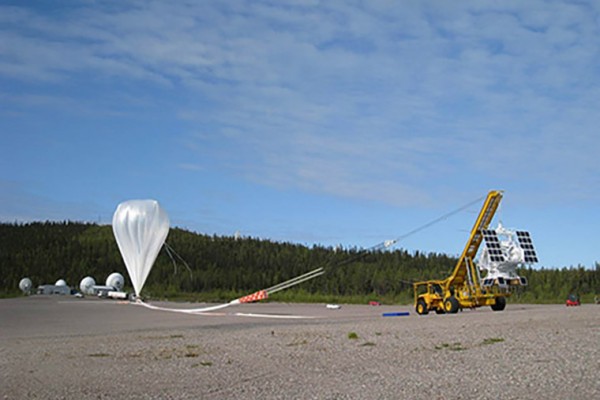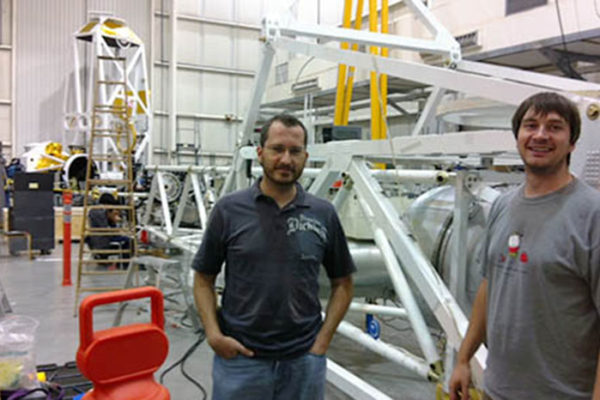Balloon rise over Fort Sumner
In a few days, a balloon-borne telescope sensitive to the polarization of high-energy “hard” X rays will ascend to the edge of the atmosphere above Fort Sumner, N.M., to stare fixedly at black holes and other exotic astronomical objects. It will be carried aloft by a stratospheric balloon that will expand to a sphere large enough to hold a 747 jetliner the float height of 120,000 feet, three times the height at which commercial aircraft fly and on the edge of Earth’s atmosphere. Launching the balloon is not child’s play.
Balloon-borne astronomy experiment X-Calibur racing to hit wind window
In a few days, a balloon-borne telescope sensitive to
the polarization of high-energy “hard” X-rays will ascend to the edge of
the atmosphere above Fort Sumner, N.M. Once aloft, the telescope will stare at black holes, neutron stars
and other exotic astronomical objects that shine brightly in the X-ray part of the spectrum in order to learn about their nature and structure. After years of preparation, the X-Calibur team is racing to get the experiment mission-ready in time for the stratospheric wind event they hope to ride.
Krawczynski group receives NASA grant to spy on black holes
NASA has just funded Henri Krawczynski and his colleague Matthias Beilicke, to launch a balloon-borne telescope sensitive to the polarization of light that will float at an altitude of 130,000 feet for a day. During that time, the balloon will stare fixedly at two black holes in our galaxy, an accreting neutron star, the Crab nebula, an extragalactic black hole and other targets yet to be chosen. One of the first instruments of its type, it should be able to make the first direct measurements of the spin rate of black holes, among other advancements.
World-renowned cosmologist to discuss Big Bang theory
P. James E. Peebles, Ph.D., one of the world’s foremost theoretical cosmologists who played a central role in understanding the evolution and structure of the universe, will deliver two talks April 15 and 16 as part of the McDonnell Distinguished Lecture Series, sponsored by the University’s McDonnell Center for the Space Sciences.
World-renowned cosmologist to discuss the Big Bang in McDonnell Center lecture series
PeeblesP. James E. Peebles, Ph.D., one of the world’s foremost theoretical cosmologists who played a central role in understanding the evolution and structure of the universe, will deliver two talks April 15-16 as part of the McDonnell Distinguished Lecture Series, sponsored by Washington University’s McDonnell Center for the Space Sciences.
WUSTL’s McDonnell Center for the Space Sciences names new director
Ramanath Cowsik, Ph.D., one of the world’s pre-eminent astrophysicists, has been named director of the McDonnell Center for the Space Sciences at Washington University in St. Louis. Cowsik, professor of physics in Arts & Sciences at Washington University, will take over as director July 1. He succeeds Roger J. Phillips, Ph.D., professor of earth and planetary sciences in Arts & Sciences, who is stepping down after seven years as director.
Physicist to be recognized for helping ‘revolutionize astronomy’
Studying stars has never been so easy, thanks to Ernst K. Zinner, Ph.D., research professor of physics and of earth and planetary sciences, both in Arts & Sciences, at Washington University. For the past 30-plus years, Zinner has helped develop and fine-tune increasingly sophisticated instruments that allow researchers to get detailed information about circumstellar and interstellar dust — actual stardust — right in their own labs. These precision instruments use a measurement technique called secondary ion mass spectrometry (SIMS). To recognize Zinner’s important contributions to the development of SIMS and its many applications in the earth and space sciences, a scientific symposium will be held Feb. 3-4 in Crow Hall, Room 201.
Cowsik elected to National Academy of Sciences
Ramanath Cowsik, Ph.D., professor of physics in Arts & Sciences at Washington University in St. Louis, recently became the 25th member of the Washington University faculty to be elected to the National Academy of Sciences. He joined 71 other new members and 18 foreign associates from 13 countries in recognition of their distinguished and continuing achievements in original research.


